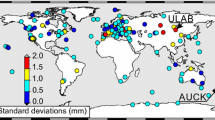Abstract
We compare two methods for monitoring the dynamic response of tall buildings to wind loading, using data from a 280-m-high building in Singapore. The first method is based on accelerometer measurements. The second method is based on the Global Positioning System (GPS) technology. The GPS can in principle detect absolute displacements with lower frequencies than the accelerometers, but the GPS positioning signal is usually very noisy. We propose a systematic procedure for modeling the stochastic and systematic components of the GPS displacement time series and for extracting the weak structural response from the dominant noise. The spectrum of the building response obtained from the filtered GPS data exhibits a dominant peak at 0.19 Hz. The frequency of the peak coincides with that obtained from the analysis of the accelerometer data. The proposed analysis of the GPS signal provides a method for cross-validating the GPS and accelerometer measurements, and shows that “educated” filtering of the GPS signal can reveal essential features of the building’s response to wind loading.








Similar content being viewed by others
References
Assimaki D, Pecker A, Popescu R, Prevost J (2003) Effects of spatial variability of soil properties on surface ground motion. J Earthq Eng 7(1):1–44
Brownjohn JMW (2005) Lateral loading and response for a tall building in the non-seismic doldrums. Eng Struct 27:1801–1812
Brownjohn JMW, Pan TC, Deng XY (2000) Correlating dynamic characteristics from field measurements and numerical analysis of a high-rise building. Earthq Eng Struct D 29(4):523–543
Brownjohn JMW, Rizos C, Tan GH, Pan TC (2004) Real-time long-term monitoring of static and dynamic displacements of an office tower, combining RTK GPS and accelerometer data. In: 1st FIG international symposium on engineering surveys for construction works and structural engineering, Nottingham, United Kingdom, June 28–July 1, 2004
Celebi M, Prescott W, Hudnut K, Behr J, Wilson S (1998) GPS monitoring of structures: recent advances. In: Raufaste NJ Jr (eds) Proceedings of the 30th joint meeting of the U.S./Japan cooperative program in natural resources panel on wind and seismic effects, May 12–15, 1998, Gaithersburg, pp 515–528. Online at: http://www.fire.nist.gov/bfrlpubs/build98/art082.html
Han S, Rizos C (1997) Multipath effects on GPS in mine environments. In: Xth international congress of the int. soc. mine surveying, Fremantle, Australia, 2–6 November, pp 447–457
Han S, Rizos C (2000) GPS multipath mitigation using FIR filters. Surv Rev 35(277):487–498
Journel AG, Huijbregts CJ (1978) Mining geostatistics. Academic, London, pp 1–600
Kijewski T, Haan F, Kareem A (2001) Wind-induced vibrations. In: Braun SG, Ewins DJ, Rao SS (eds) Encyclopedia of vibration. Academic, New York, pp 1578–1587
Li XL, Ge L, Ambikairajah E, Rizos C, Tamura Y, Yoshida A (2006) Full-scale structural monitoring using an integrated GPS and accelerometer system. GPS Solut. DOI 10.1007/s10291-006-0023-y
Mertikas SP (1994) The description of accuracy using conventional and robust estimates of scale. Mar Geod 17:251–269
Ogaja C (2001) On-line GPS integrity monitoring and deformation analysis for structural monitoring applications. In: 14th Int. tech. meeting of the satellite division of the U.S. inst. of navigation, Salt Lake City, 11–14 September, pp 989–999
Ogaja C, Wang J, Rizos C (2003) Detection of wind-induced response by wavelet transformed GPS solutions. J Surv Eng ASCE 129(3):99–104
Press WH, Teukolsky SA, Vetterling WT, Flannery BP (1992) Numerical recipes in Fortran, vol 1, 2nd edn. Cambridge University Press, New York
Sòlnes J (1997) Stochastic processes and random vibrations. Wiley, New York, pp 1–432
Yaglom AM (1987) Correlation theory of stationary and related random functions I: basic results. Springer, Berlin Heidelberg New York
Acknowledgments
We acknowledge useful conversations with Prof. Chris Rizos (School of Surveying and Spatial Information Systems, University of New South Wales, Sydney, Australia). Part of this research was supported by the PYTHAGORAS-II (Environment): Technical University of Crete, No. M 2.6, MIS 97511, O.P. “Education”, Third Community Support Framework co-financed by the European Social Fund.
Author information
Authors and Affiliations
Corresponding author
Appendix: Semivariogram of random process with periodic trend
Appendix: Semivariogram of random process with periodic trend
Let X(t) = w(t) + η(t), where w(t) is a periodic trend and η(t) a correlated random process. The experimental semivariogram of X(t) is defined by means of Eq. (12). In light of the following function:
the semivariogram of X(t) is given by the following:
where γηη (p t s ) is the noise semivariogram. The cross-term γηw (p t s ) is zero, since the periodic function w(t) and the random process η(t) are uncorrelated. Finally, for N − p >> 1 the term γ ww (p t s ) can be approximated as follows:
If w(t) = Acos (ω0t + ϕ), explicit calculation of the right hand-side of Eq. (16) leads in connection with Eq. (15) to the result of Eq. (13).
Rights and permissions
About this article
Cite this article
Hristopulos, D.T., Mertikas, S.P., Arhontakis, I. et al. Using GPS for monitoring tall-building response to wind loading: filtering of abrupt changes and low-frequency noise, variography and spectral analysis of displacements. GPS Solut 11, 85–95 (2007). https://doi.org/10.1007/s10291-006-0035-7
Received:
Accepted:
Published:
Issue Date:
DOI: https://doi.org/10.1007/s10291-006-0035-7




